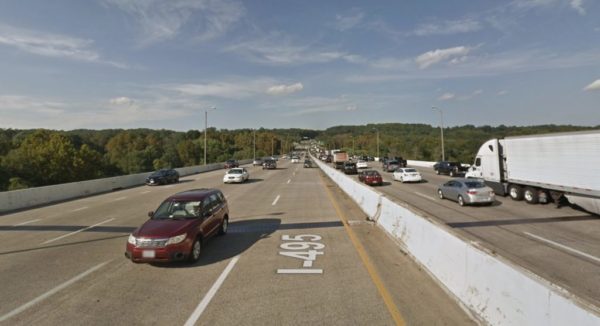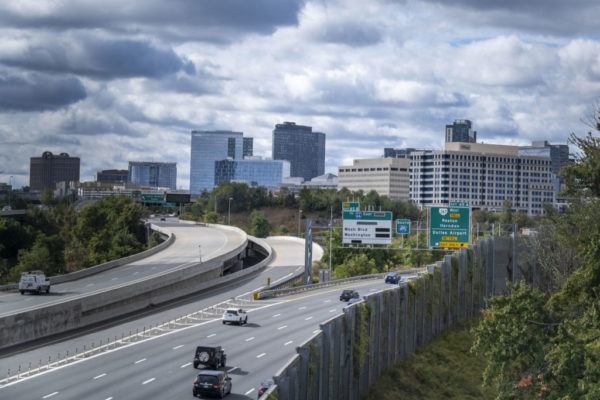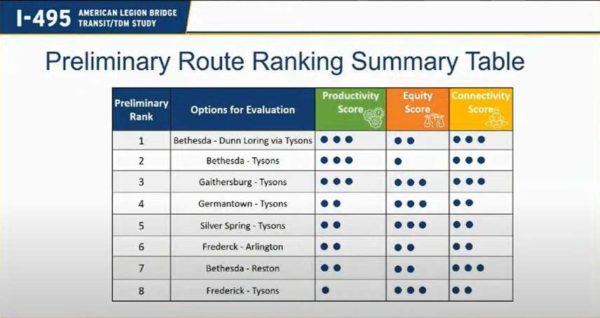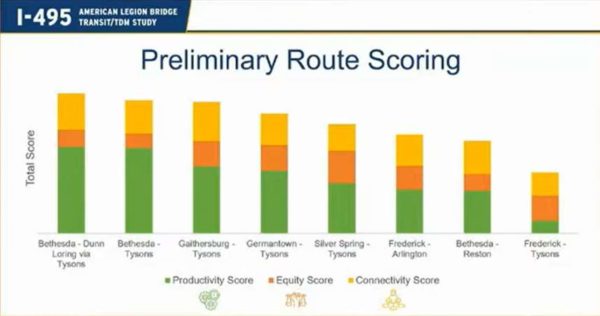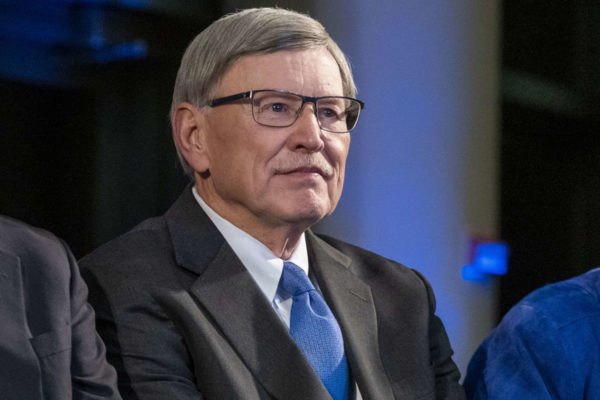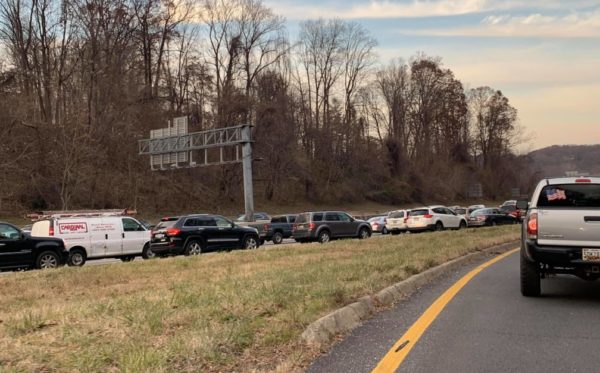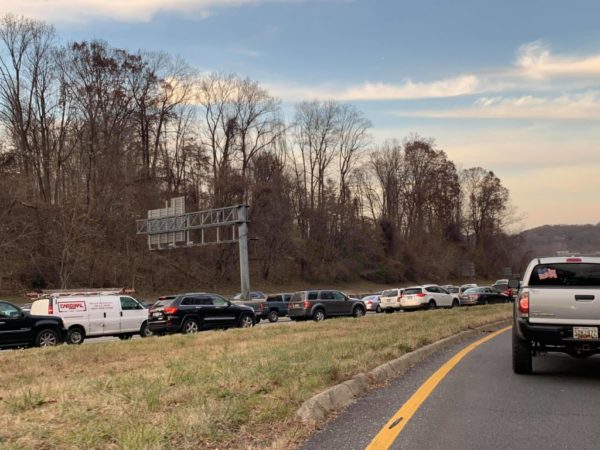Members of the Fairfax County Board of Supervisors share numerous concerns about the environmental impact of the I-495 Express Lanes Northern Extension (495 NEXT) project.
Based on an environmental assessment released in February, the board’s comments highlight everything from traffic and transit to stormwater management, along with recommendations to minimize the impact on trees, waterways, streams, historic properties and noise.
“The Board requests that VDOT continue to allow time for the public to provide feedback on the project prior to executing a final contract,” Chairman Jeffery McKay said in a letter to Virginia Secretary of Transportation Shannon Valentine that the board is scheduled to approve when it meets today (Tuesday).
The project is intended to add more capacity to I-495 to take some of the cut-through traffic off nearby McLean streets, but without expanding the American Legion Bridge and I-495 on the Maryland side, some are concerned the express lanes will only push the bottleneck further north.
A traffic analysis found that generally, travel time along the Capital Beltway corridor will improve in both 2025 and 2045 once Maryland completes their managed lane system.
Until Maryland completes its improvements, the analysis predicted delays along general purpose lanes going north on I-495. In response, the board urged the Virginia Department of Transportation to shorten the time between the opening of the two projects.
“It is critical that VDOT address the temporary impacts of opening prior to Maryland’s managed lanes,” they said.
As part of the 495 NEXT project, VDOT has committed to building a major regional trail in accordance with Fairfax County’s Comprehensive Plan. The Board of Supervisors is requesting that the trail continue through Tysons instead of ending at Lewinsville Road.
They also urged VDOT to find money to promote transit access along the corridor, which will help reduce single-occupancy vehicle ridership and encourage sustainable transportation system.
Stormwater management ranks among Fairfax County’s top environmental concerns for 495 NEXT. Noting that flooding has particularly been an issue in the McLean area, the board wants VDOT to meet county requirements, rather than being grandfathered into lenient state standards.
“If meeting our local stormwater management requirements is not attainable, VDOT should implement requirements to the maximum extent practicable and provide documentation demonstrating that the technical requirements are not fully feasible,” McKay said in the letter. Read More
The Virginia Department of Rail and Public Transportation is currently exploring possibilities for adding more transit routes to Tysons along the Interstate 495 corridor as part of its I-495/American Legion Bridge Transit and Transportation Demand Management Study.
Joined by Virginia Department of Transportation and Maryland Transit Administration officials, DRPT presented some potential options for new connections at a public meeting on Wednesday (Nov. 18) that provided updates on the transit study and VDOT’s I-495 Express Lanes Northern Extension (495 NEXT) project.
DRPT officials have identified Tysons, Dunn Loring, Reston, and Arlington as key destinations in the corridor, noting that there tends to be more demand for travel from Maryland to Virginia than the other way around.
“There is significant travel between activity centers on the Maryland 355 corridor and Silver Spring to destinations like Tysons, Dunn Loring, and the Virginia Route 7 corridor,” DRPT Northern Virginia Transit Planning Manager Ciara Williams said. “A great deal of transit services operate in the study area. However, there are no transit services today that directly link the major activity centers.”
After looking at a variety of potential transit connections between Virginia and Maryland on 495, DRPT singled out eight possibilities that merited further study and ranked them based on their ability to add ridership relative to their cost, the service they would provide to low-income and minority populations, and the number of people and jobs to which they would improve access.
Five out of the eight preliminary possible transit routes go to Tysons. A sixth route – and the one that received the highest score – goes through Tysons to connect Bethesda and Dunn Loring.
A proposed transit route that would go from Gaithersburg, Md., to Tysons during the morning peak period and in the other direction during the evening peak period is the only one that got a top score for productivity, equity, and connectivity.
However, the Bethesda-Dunn Loring and Bethesda-Tysons routes ranked higher, because a trips-per-day metric included in the productivity score was weighted higher to prioritize routes with the potential to yield the highest ridership levels, according to Williams.
The other routes that DRPT is considering evaluating further are Germantown to Tysons, Silver Spring to Tysons, Frederick to Arlington, Bethesda to Reston, and Frederick to Tysons.
The American Legion Bridge transit study started in December 2019 after Virginia Gov. Ralph Northam and Maryland Gov. Larry Hogan announced an agreement to fund the $1 billion project to replace and widen the bridge, which is part of the Capital Beltway and currently the only way to travel between Maryland and Virginia without going through Washington, D.C.
“495 is one of the most congested roadways in all of Maryland and Virginia, and traffic is forecasted to increase in the future,” Williams said. “…We see that there’s a need for transit and TDM solutions in conjunction with the planned and managed Express Lanes to efficiently and effectively serve travel across the bridge.”
The transit study is being conducted in parallel with the proposed 495 NEXT project, which extends the existing 495 Express Lanes roughly three miles from the Dulles Toll Road and I-495 interchange to the George Washington Memorial Parkway near the American Legion Bridge.
DPRT Transportation Chief Jennifer Debruhl says the study team anticipates releasing its draft recommendations for public comment in early December before finalizing the study early next year.
Staff photo by Jay Westcott, slides via Virginia Department of Rail and Public Transportation
In the series of Q&A discussions, the Virginia Department of Transportation (VDOT) discussed plans to extend the 495 express lanes to the American Legion Bridge. Concerns from local residents about the project ranged from impact on the road to impact on surrounding communities.
While VDOT mostly maintained that the project will help travel times on I-495 and reduce impact on nearby neighborhood traffic, there were other areas where VDOT said the I-495 expansion may not live up to some hopes.
Implementation of dedicated transit, for instance, may not be in the cards without a public subsidy.
“Currently our number one goal is no public subsidies or funding to have this improvement on the Beltway,” said Susan Shaw, director of mega-projects for VDOT. “There’s not been any decision made about whether there would be additional revenue available for any type of transit, and there hasn’t been that kind of commitment, but we’re in discussions with Transurban. First and foremost goal is to complete the project without any public subsidy.”
In response to concerns about 118 acres of tree loss associated with the project, Shaw also said equal reforestation could be tricky.
“When we do reforestation, it needs to be within VDOT write of way,” Shaw said. “We’re often challenged to find space in right of way to do reforestation. Right now, we don’t have a specific budget. That will be something we work through as part of our work as we move into the final design.”
Shaw said the 118 acres projection would be maximum tree loss and VDOT is still working to minimize that.
The project is intended to add more capacity to I-495 to take some of the cut-through traffic off nearby McLean streets, though there are concerns without expansion of the American Legion Bridge and expansion on the Maryland side, the express lanes will only push the bottleneck further north.
Photo via Google Maps
Dranesville District Supervisor John Foust said he’s supportive of plans to extend the express lanes on I-495, but has major concerns about the timing of the project with Maryland’s piece.
The I-495 Northern Extension Project would expand express lanes from the Dulles Toll Road to the George Washington Memorial Parkway, replace overpasses and noise walls and add a shared-use path. The project could save drivers up to 25 minutes during peak-hour commute times, according to the presentation given at the meeting.
Toll revenues are expected to support the cost of the project, according to the presentation.
Maryland is currently evaluating its options to rebuild and widen the American Legion Bridge, Susan Shaw, from the Virginia Department of Transportation, told the Fairfax County Board of Supervisors.
Preliminarily, construction could start on Virginia’s portion of the project in 2021 and take three years to finish, Shaw said.
“Obviously, solving the congestion issues at the American Legion bridge are just absolutely essential that we do that,” Foust said at the Transportation Committee meeting on Tuesday. “This project doesn’t solve the congestion problems.”
While Foust said that the project is a “necessary piece of the puzzle that will do that,” he said that most of the relief will come from increasing capacity and widening the Beltway from Maryland.
Foust said he thinks it would be a “huge mistake” to start the Virginia part of the project before it can get aligned with Maryland’s timeframe.
“Timing is everything here,” Foust said. “You’ve got to get this coordinated better with what they’re doing in Maryland or a bad situation is going to get worse.”
A public meeting on the project is set for March 12 at Langley High School (6520 Georgetown Pike) from 6:30 to 8:30 p.m. Public comments will be accepted through March 30, although Shaw said the public can reach out anytime after that.
“You want to extend the express lanes, but that’s not a good enough public purpose reason for doing this,” Foust said.
In a newsletter to constituents today, Dranesville District Supervisor John Foust said a meeting in March will solicit community input on the American Legion Bridge.
Currently, the 495 Express Lanes Northern Extension project — a.k.a. 495 NEXT — would extend the 495 Express Lanes north from the I-495 and Dulles Access Road interchange up to the American Legion Bridge and add two new tolled express lanes in each direction.
The Virginia Department of Transportation (VDOT) is set to present the results of the 495 NEXT environmental study and traffic analysis on Thursday, March 12.
Foust’s newsletter said that “one of the biggest transportation challenges in the McLean area is the congestion caused by inadequate capacity on the American Legion Bridge and the Maryland side of the Beltway.”
More from the newsletter:
In early 2019, VDOT signed a nonbinding Development Framework Agreement with Transurban. Delivering the project through this public private partnership would mean that no public funding by the Commonwealth is needed to extend the Express Lanes network. If approved, the project will replace Live Oak Drive, Georgetown Pike, and Old Dominion Drive Bridges and allow for the installation of pedestrian/bike facilities along the corridor. Construction could begin as early as 2021.
Virginia officials have been cautious about moving forward with the project because without replacing the American Legion Bridge, bottlenecks and congestion will only be relocated, not resolved.
A major development occurred late last year when Virginia Governor Northam and Maryland Governor Hogan announced “The Capital Beltway Accord.” The agreement is a commitment to work together to create a new, unified Capital Beltway and replace the aging American Legion Bridge. The cost of the bridge project is expected to be $1 billion and both states will contribute to the cost through public-private partnerships. The private entity will pay the upfront costs in exchange for future toll revenue meaning toll payers rather than taxpayers will foot the bill.
The new bridge will have four express toll lanes, in addition to eight free lanes, as on the current span. The tolls will fluctuate based on congestion, rising to keep traffic flowing freely. Construction could begin in 2022 and would likely take five or six years.
The next key piece of the puzzle is ensuring that the widening of I-495 just over the bridge in Maryland is done in coordination with the bridge project. Governor Hogan recently obtained a key vote to advance a plan to widen the Beltway from the American Legion Bridge to the Interstate 270 spur, and along the lower part of I-270 between the Beltway and Interstate 370.
“I am excited that we are making progress on addressing congestion issues that have plagued our communities, but I want to be sure that the project is done in a way that actually addresses our problems, rather than just moving them,” Foust said in the newsletter.
At the March 12 meeting, attendees will be able to provide input during a public hearing.
The meeting is set to run from 6:30-8:30 p.m. at Langley High School in McLean (6520 Georgetown Pike).
New Route 7 Rapid Bus System Plans — “A new conceptual engineering report lays out 18 specific bus rapid station locations from Tysons to Alexandria. It also details the spots where buses would have their own lanes in the middle of the road or on the outside of the road, and where buses would share lanes with car traffic.” [WTOP]
Update on Park Police Shooting of Tysons Man — “The two U.S. Park Police officers who fatally shot unarmed motorist Bijan Ghaisar in 2017 will not be charged with any crimes in connection with the incident, federal prosecutors said Thursday. The decision came just days before the second anniversary of the slaying.” [Washington Post]
Orange Line Work Next Year — “Orange Line trains could run on a single-track at West Falls Church, and Orange and Silver Line trains could pass through East Falls Church without stopping. The closures would run as long as May 23 (Memorial Day weekend) through about Aug. 28 (before Labor Day weekend).” [WTOP]
Residents Displaced From Falls Church Fire — On Saturday, firefighters battled a “fire in a garden-style apartment building in the 7300 block of Lee Highway in the Falls Church area of Fairfax County. Multiple people have been rescued.” [Fairfax County Fire and Rescue/Twitter]
Questions About American Legion Bridge’s Reconstruction? — The Washington Business Journal has answers about how much the bridge work will cost, who is paying for it and more. [Washington Business Journal]
(Updated at 10:15 a.m.) Tysons area commuters heading to and from Maryland on the Beltway may see some relief from the constant traffic woes.
The governors of Virginia and Maryland announced an agreement Tuesday morning that would see the construction of a new American Legion Bridge.
The agreement to rebuild the bridge is being billed as “historic” and “a big win for Northern Virginia, the metro region, and our entire Commonwealth” by Virginia Gov. Ralph Northam (D).
The new bridge will “relieve congestion at one of the country’s worst traffic chokepoints,” according to a press release, below. “The project is expected to cut commuting time in half for many travelers, reduce congestion in the regular lanes by 25 percent, provide 40 percent more lane capacity over the old bridge, and include bicycle and pedestrian paths across the Potomac River.”
The new bridge will be build on largely the same footprint as the existing bridge, but with two new express lanes in both directions. The initial stages of construction could begin as early as 2021.
Proud to stand with @GovLarryHogan to announce our new, historic Capital Beltway Accord. Finally, our two states have come together to rebuild the American Legion Bridge—a big win for Northern Virginia, the metro region, and our entire Commonwealth.https://t.co/lamx5p3zqr pic.twitter.com/av4wOhzYjI
— Ralph Northam (@GovernorVA) November 12, 2019
More via a press release from the governor’s office:
Governor Ralph Northam (D-VA) and Governor Larry Hogan (R-MD) today announced a bi-state, bipartisan accord to create a new, unified Capital Beltway, replace the aging American Legion Bridge and relieve congestion at one of the country’s worst traffic chokepoints. The two governors made the announcement at the annual Capital Region Transportation Forum in Washington, DC.
“A new bridge means commuters will get to work and back home faster,” said Governor Northam. “Our teams have identified a way to fix one of the worst traffic hot spots in the country. This demonstrates what can get done when leaders come together to find shared solutions to tough regional problems. This is about helping people see their families more, grow their businesses, and further unlock the region’s vast economic potential.”
“The ‘Capital Beltway Accord’ is a once-in-a-generation achievement for the capital region,” said Governor Hogan. “A bipartisan, commonsense, interstate agreement such as this has eluded elected leaders throughout the region for many decades. Together with our partners in Virginia, we are building a foundation for even greater economic growth, greater opportunity for our citizens, and advancing real, lasting, transformative improvements for the entire Washington metropolitan region.”
The project complements ongoing plans by both governors in their jurisdictions–advancing a region-wide vision for a seamless network of reliable travel options around the Capital Beltway, and along Interstates 270 and 95, 395, and 66.
The project is expected to cut commuting time in half for many travelers, reduce congestion in the regular lanes by 25 percent, provide 40 percent more lane capacity over the old bridge, and include bicycle and pedestrian paths across the Potomac River.
The American Legion Bridge has been operating beyond its capacity for nearly four decades. Daily traffic has grown 390 percent since the bridge opened in 1962, with 235,000 vehicles using it daily. More than 40 percent of the region’s population travels this segment of the Capital Beltway, and the region expects to grow by another 1.2 million people by 2040. Both governors have made it a top priority to identify a long-term, seamless solution for the Capital Beltway.
The project will replace the existing lanes in each direction across the Potomac River and add two new Express Lanes in each direction for approximately three miles between the George Washington Memorial Parkway in Virginia to the vicinity of River Road in Maryland. New bicycle and pedestrian access will connect trails on both sides of the Potomac River. The project is being designed predominantly within the footprint of the existing bridge and right-of-way to minimize impact to travelers, the environment, and surrounding communities. No homes or businesses are expected to require relocation.
“This is once-in-a-generation project that will improve accessibility throughout the region,” said Virginia Secretary of Transportation Shannon Valentine. “This is a milestone in regional cooperation. We in Virginia look forward to working hand-in-hand with Maryland to deliver this transformative transportation solution.”
A long-awaited project to lessen congestion at an intersection near the American Legion Bridge in McLean is nearing completion.
The Virginia Department of Transportation expanded the intersection by 550 feet to include a left turn and right turn lane, as well as an option for traffic to go straight into the nearby neighborhood. The renovations also include an area where law enforcement can safely pull over traffic.
Crews worked on the three-month-long project at the intersection of Georgetown Pike and Balls Hill Road over the summer. Politicians gathered Thursday morning (Aug. 22) to survey the scene and celebrate the project.
Allison Richter, a VDOT liaison for Fairfax County, attended the event and said that people in the nearby neighborhood struggled to get home when others were trying to turn onto American Legion Bridge or onto the freeway. The addition of turn lanes is expected to ease traffic around rush hour, she said.
Richter said that this was part of a $500,000 project to improve traffic flow in the area, which should be completed in the next couple days. She also said that roughly $250,000 of the funds came from Fairfax County while the remaining $250,000 came from an operations safety budget.
“This is one of the rare occasions we meet at this intersection on a happy note,” Dranesville District Supervisor John Foust told the gathering. “This has been a challenge to deal with the intersection and try to meditate the impact on the surrounding neighborhoods from the American Legion Bridge and back up on the ramp.”
Road crews had to redirect some attention from the work on Balls Hill Road to roads impacted by severe flooding in early July, Foust said.
Crews are still working to repair Kirby Road, which is still closed due to flooding damage, he said, adding that the floods completely rerouted the river, which now flows underneath the road.
The city needs to get permits from the Army Corps of Engineers to fix the damage.
“There is only so much we can expedite,” Foust said, adding that he believes that the residents have been patient with the process.
As for the road crews, “I don’t know if I’ve ever seen VDOT so focused,” Foust said.
Just in time for #backtoschooll! VDOT crews completed improvements incl a dedicated left-turn lane to help ease congestion at Balls Hill Rd & Georgetown Pike in McLean. Take a look! Thanks to our partners @fairfaxcounty @FairfaxCountyPD @johnfoustva @kmurphyva @BarbaraFavola! pic.twitter.com/es74W6OVfJ
— VDOT Northern VA (@VaDOTNOVA) August 22, 2019
After the Beltway was paralyzed by a tanker crash near the American Legion Bridge last Thursday, questions have again surfaced about the possibility of a new connection between Northern Virginia and Maryland.
Potential solutions have included expanding the proposed “Purple Line” from Maryland down to Tysons. But this type of connection doesn’t come without a share of difficulties, and Dranesville District Supervisor John Foust says Virginia can’t afford to take its eye off the more attainable prize of fixing the American Legion Bridge first.
“The first priority has to be fixing the issues at the American Legion Bridge,” Foust said. “We have the cooperation of Maryland on that. But based on what just happened with the shutdown, it’s critical that we consider building a parallel bridge as opposed to just widening the one we have. That gives us some redundancy in the event of a crash like this or a terrorist attack, so we don’t shut down Northern Virginia.”
But an expansion of the American Legion Bridge, much less an entirely new one, has raised concerns that another crossing would add new roads through the Montgomery County Agricultural Reserve on the Maryland side, though some have said this impact is likely overblown.
“It raises serious environmental issues that have to be addressed, but it takes both sides of the river to cooperate and agree,” Foust said. “Historically, Virginia has been more inclined to do it than Maryland, who has been more insistent that they do not want another bridge.”
Frank Shafroth, director of the Center for State and Local Leadership at George Mason University, said there’s political momentum to push for the new connection despite the obstacles.
“Foust is correct about the challenge — not a challenge all that different from the initial challenge of the Beltway itself,” Shafroth said. “But leaders in this region have demonstrated, over the years, a practical ability to be creative in resolving these kinds of governance challenges: they tend to be far more practical than many federal elected officials, and much more accountable to constituents.”
Foust is far from alone in pushing for a new route over the Potomac. Springfield District Supervisor Pat Herrity expressed frustrations at the crash’s impact on regional traffic on Twitter.
Yesterday was yet another reminder of the critical need of the region to build a northern crossing over the Potomac River. It is past time to build the crossing. pic.twitter.com/r26JqQx0xp
— Supervisor Pat Herrity (@PatHerrity) March 29, 2019
In an ideal world, Foust said he would like to see more transit options on the Beltway, like dedicated bus lanes. However, transit options like a new Metro line are too far off to consider in transportation plans, Foust argues.
“I don’t think we can wait to get light or heavy rail to make that route from Maryland to Virginia,” Foust said. “We have to move forward with the bridge if possible, and provide the ability to add rail at a later date.”
Virginia recently approved new express lanes that will extend to the American Legion Bridge. Though unlikely to do much to relieve the crush of rush hour traffic, Foust says the lanes should offer some relief by giving Beltway drivers headed to the George Washington Parkway rather than the American Legion Bridge another option to get around traffic.
“But nobody thinks we’re going to solve the problem until Maryland does what they need to do with regards to that bridge and the capacity for the Beltway on the Maryland side,” Foust said. “Virginia is prepared to move forward. Maryland I think is talking as early as 2022 to begin construction, but realistically they have a lot of issues to resolve first. But I think [this crash] put an exclamation point on the fact that we need a solution.”
In January, Maryland’s highway administrator Greg Slater told WUSA9 that a new bridge should be built within the next few years and that it was a top priority of Maryland Governor Larry Hogan.
The I-495 Express Lanes are pushing north to the American Legion Bridge.
As part of a suite of new agreements signed between Virginia officials and Transurban, the private company that operates the express lanes. According to an announcement today from Gov. Ralph Northam’s office:
Four general purpose (GP) lanes and two new Express Lanes will run in each direction of the Capital Beltway starting from the current terminus near the Dulles Access Road and ending at the American Legion Bridge. With no public funding by the Commonwealth, the Express Lanes network will be extended to the Maryland border, helping address one of the worst bottlenecks in the region and reduce cut-through traffic in local McLean neighborhoods.
The express lanes have tolls that range from 20 cents per mile to $1.25 per mile during rush hour with no official cap. Cars with three or more people do not have to pay the toll.
The announcement follows Maryland’s $9 billion investment announced in 2017 that included toll lanes on the northern side of the bridge.
The area of McLean on the Virginia side of the American Legion Bridge has long been an infamous congestion hotspot. An average of 239,000 people use the bridge every workday, and Dranesville District Supervisor John Foust warned that the bridge is “grossly over capacity” and in dire need of expansion.
“I am delighted that Governor Northam and his team have found a way to expand capacity on I-495, heading up to the American Legion Bridge,” State Sen. Barbara Favola (D-31st District) said in a press release. “This improvement demonstrates Virginia’s commitment to easing traffic throughout the region and provides further incentives for Maryland to help address congestion on the Bridge.”
As part of the deal, Transurban agreed to construct a new southbound lane on I-95 near the Occoquan Bridge in the Woodbridge area, another infamous bottleneck for regional traffic.


